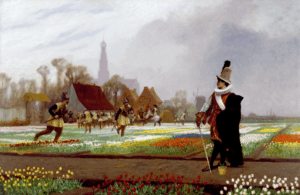 This day-school opens with a survey of the Dutch Golden Age in politics and art. We begin with the establishment of the Dutch Republic in 1588 and end with the Rampjaar (‘Terrible Year’) of 1672 when the French invaded and the art market collapsed.
This day-school opens with a survey of the Dutch Golden Age in politics and art. We begin with the establishment of the Dutch Republic in 1588 and end with the Rampjaar (‘Terrible Year’) of 1672 when the French invaded and the art market collapsed.
There will be a case study of the tulip mania that gripped Holland in the 1630s; someone once offered 12 acres of land for a single bulb. Speculation peaked in 1637, when the state intervened and many people were ruined.
This craze led to a remarkable series of paintings, satires, and novels; including later works such as Alexandre Dumas “The Black Tulip” (1850) and Deborah Moggach “Tulip Fever” (1999).
We move from tulips to the rise of the civic portrait, beginning with Frans Hals “Laughing Cavalier” (1624) and climaxing with Rembrandt’s masterpiece “The Night Watch” (1642). Simon Schama called the latter “the crowning glory…of Amsterdam, of Dutch painting, of all Dutch art”.
Other featured artists include Pieter de Hooch, Jan Steen, and Johannes Vermeer. There will also be DVD illustrations from Kenneth Clark’s “Civilization” (1969) and feature films such as “Barbara” (2012) and “Tulip Fever” (2017). Explore some of the more curious emblems in Dutch culture (cows, swans, and thistles). Find out why the Princess of Orange was rebuked for buying a painting of a cow pissing on a goat.
